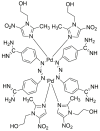Platinum and Palladium Complexes as Promising Sources for Antitumor Treatments
- PMID: 34361037
- PMCID: PMC8347039
- DOI: 10.3390/ijms22158271
Platinum and Palladium Complexes as Promising Sources for Antitumor Treatments
Abstract
There is a need for new, safer, and more effective agents to treat cancer. Cytostatics that have transition metals at their core have attracted renewed interest from scientists. Researchers are attempting to use chemotherapeutics, such as cisplatin, in combination therapy (i.e., in order to enhance their effectiveness). Moreover, studies are being carried out to modify molecules, by developing them into multinuclear structures, linking different compounds to commonly used drugs, or encapsulating them in nanoparticles to improve pharmacokinetic parameters, and increase the selectivity of these drugs. Therefore, we attempted to organize recent drug findings that contain palladium and platinum atoms in their structures.
Keywords: anticancer treatments; palladium complexes; platinum complexes.
Conflict of interest statement
The authors declare no conflict of interest.
Figures




















References
-
- Kauffman G.B., Pentimalli R., Doldi S., Hall M.D. Michele Peyrone (1813–1883), Discoverer of Cisplatin. Platin. Met. Rev. 2010;54:250–256. doi: 10.1595/147106710X534326. - DOI
-
- Rosenberg B. Platinum Complexes for the Treatment of Cancer. Interdiscip. Sci. Rev. 1978;3:134–147. doi: 10.1179/030801878791926119. - DOI
-
- Hainsworth J.D., Johnson D.H., Greco F.A. Cisplatin-based combination chemotherapy in the treatment of poorly differentiated carcinoma and poorly differentiated adenocarcinoma of unknown primary site: Results of a 12-year experience. J. Clin. Oncol. 1992;10:912–922. doi: 10.1200/JCO.1992.10.6.912. - DOI - PubMed
-
- Gilligan T., Lin D.W., Aggarwal R., Chism D., Cost N., Derweesh I.H., Emamekhoo H., Feldman D.R., Geynisman D.M., Hancock S.L., et al. Testicular Cancer, Version 2.2020, NCCN Clinical Practice Guidelines in Oncology. J. Natl. Compr. Cancer Netw. 2019;17:1529–1554. doi: 10.6004/jnccn.2019.0058. - DOI - PubMed
Publication types
MeSH terms
Substances
LinkOut - more resources
Full Text Sources
Medical

